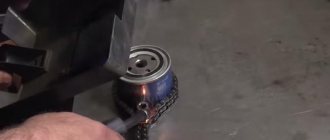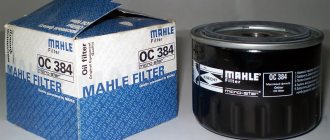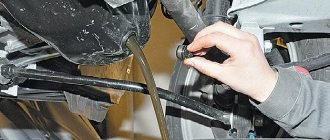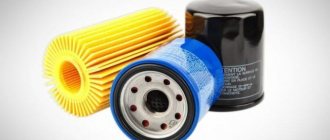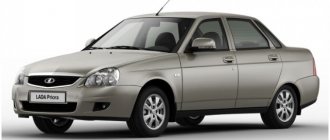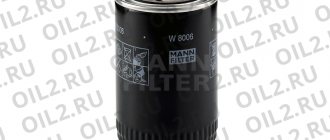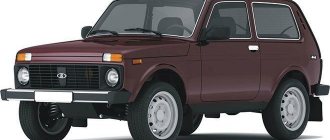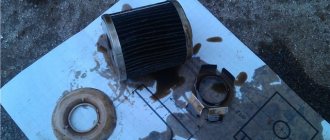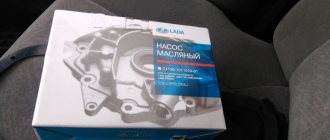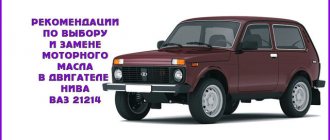Regardless of why you don’t want to go to a car service to change the oil in your car’s engine, the oil will still have to be changed after a certain period of time (mileage). And with it the oil filter. And this filter sometimes gets stuck so that even though you wrap it by hand, it is not possible to unscrew it without special tools. In our article we will offer four effective ways to unscrew the oil filter without a key or a special puller in a regular garage.
What to do next?
When the old filter is removed, before installing a new one in its place, be sure to wipe the mounting area with a rag, pour oil into the filter itself, and do not forget to lubricate the rubber gasket with it. Only after this can the new part be considered ready for installation. Screw it into place (you don’t need to put much effort into this), turn on the ignition and let the engine warm up, while you observe the repair site. If everything is done correctly, oil will not ooze out from under the filter.
Replacement process
Replacing the oil filter on a Logan is carried out in several stages: the engine oil is drained, the gasket on the plug is changed and, accordingly, a new filter unit is installed. It is best to carry out the process on an overpass or pit so that you can freely climb under the hood. Operating time: no more than 15-25 minutes.
For repair you will need:
- special puller;
- container for used motor oil;
- new oil element;
- hammer and screwdriver;
- key for 10 and key for 17;
- key for the drain plug;
- canister of suitable motor oil.
The location of the part on a Renault Logan car requires the observance of certain precautions: in particular, carry out repairs in overalls and gloves and do not touch other parts if the engine has been preheated.
The process of replacing the oil filter in Renault Logan:
- Unscrew the bolts on the filter cover with a wrench;
- Loosen the tightening on the drain plug;
- place a container under the motor;
- wait until the used lubricant is completely released;
- Screw the plug tightly with a wrench and screw on the drain plug;
- unscrew the old unit. It's better to use a puller. Before unscrewing, clean the attachment point;
- We wipe the seat with a rag;
- apply new grease to the sealing ring;
- Fill the new unit with oil to the middle;
- manually tighten the spare part;
- pour 3.4 liters of liquid through the filler plug;
- tighten the filler plug with a 17 mm wrench;
- start the engine and check the special low pressure sensor;
- inspect the work site and add lubricant if necessary.
In a short period of time, by performing the repair process, you can extend the life of the oil system on Renault Logan.
Second method
Unscrew the oil filter using special keys previously purchased at a car store; they come in two main types:
- Chain key.
- Crab Key.
Chain key
crab key
Having decided to purchase a special key, choose the first option; it is more reliable and is more often used by service station workers.
Method No. 2.
When it was not possible to unscrew the oil filter using the first method, then instead of a towel we take sandpaper. From a piece of sandpaper, cut a strip with a width equal to the height of the oil filter. Then we wrap a cut piece of sandpaper around the oil filter and unscrew it.
This method allows you to unscrew not only a tightly tightened oil filter, but also a stuck one. However, not every stuck filter can be unscrewed with sandpaper, so method No. 3 comes to the rescue.
Reasons why the oil filter is not dismantled
To unscrew the old filter, you need to place the car on a pit or lift the car using a lifting device. Then you need to unscrew the old filter, but difficulties may arise here. If it does not come off, this may be due to its sticking. The motor becomes very hot during operation. Because of this, parts that are not very heat-resistant melt. Such components include a rubber gasket, which is included in the design of the oil filter. It can melt and stick to the engine, especially if oil gets on the gasket.
Problems arise when the filter is twisted too tightly. When changing the filter element, you need to tighten it well so that the rubber band is pressed tightly against the motor. In this case, the oil filter is often screwed on too tightly, especially when using a wrench. If you take into account the melting of the gasket, it becomes clear that unscrewing the filter will be enough.
It is important that the oil filter is not located in the most convenient place, therefore, it becomes impossible to exert maximum effort to unscrew it. In addition, when unscrewing, your hands get dirty with oil and slip.
Lubrication system for k4m and k7m (k7j) engines
In general, the lubrication system is designed like this: there is an oil pump, which is driven by the crankshaft (timing mechanism), and it transfers oil from the sump to the main line. The first part installed in the line is the oil filter - it needs to be changed periodically.
If there is insufficient oil pressure, the switch contact opens and then the indicator is activated. Parts that allow diagnostics include the control dipstick - it is immersed in the engine sump. On motors K4M and K7M, the dipstick is located at different points: in Fig. 1 it is designated by the number 5, in the second figure – by the number 7.
List of important elements:
- Oil filler plug: element 7 (Fig. 1) and 1 (Fig. 2);
- Drain plug: located at the bottom of the engine sump;
- Oil filter housing: 19 and 6 respectively.
To unscrew the filter, you need a puller. If it is not there, a hole is made in the body closer to the bottom, and then an awl or screwdriver is used as a lever. The filter is dismantled after draining the oil. Before installing a new filter, on the contrary, it is filled with oil.
The drain plug is unscrewed with an 8 square. There will be a washer under the plug. A replacement is allowed - a copper washer with an internal diameter of 18 mm (advice from the magazine “Behind the Wheel”).
The original oil filter is suitable for all engines discussed here. Its number in the Renault catalog is 7700274177. Sellers, moreover, use the designation 7700274177FCR210134. And Renault has a filter 8200768913, which is also suitable. Good luck with your choice.
Removal using special pullers
Service technicians and experienced garage repairmen use special pullers to remove the filter element. They are available in 3 types:
- chain;
- crab;
- clamping (tape, screw).
Experts prefer chain pullers, which have greater power and reliability and are suitable for any type of filter elements. Therefore, service station technicians usually remove the oil filter with a chain wrench.
Special pullers can be purchased at auto stores. The key is placed on the body of the part being removed and securely fixed. It remains to remember that the dismantled element must be unscrewed counterclockwise. After removing the filter, make sure that the gasket is not stuck to the motor block. If necessary, remove the gasket or its parts with a scraper.
Inconveniences for the driver
Car modifications have individual principles for attaching the oil filter. What remains common is the lack of space around them, since the layout of the power units is so compact that it is almost impossible to “crawl” in to screw together the oil cup. Difficulties include the adhesion of rubber seals to metal.
Based on the above, they conclude that a specific engine requires “its own” device or universal puller. When developing your own design, you need to focus on factory analogues of oil filter pullers sold in car dealerships.
The oil filter does not unscrew: what to do?
If you can’t unscrew the oil filter yourself, you can suggest that someone who has more strength try to do it. In most cases, you can unscrew even a strongly “stuck” oil filter without unnecessary tricks. But when you cannot unscrew the element even with outside help, you can use one of the methods described below:
- Special wrench for oil filters. In automobile accessory stores you can find a special wrench designed to unscrew oil filters of various diameters. It is enough to hook such a key onto the element and then start rotating. Using it to unscrew the oil filter is not difficult, but not all drivers have such a key, and you must first purchase it;
- Creating a lever. In the garage you can always find a lot of unnecessary parts and various tools from which you can build a lever. For example, you can put an old timing belt or generator belt on the key, then tie it around the filter and start rotating. Due to the unique lever and the absence of rubber sliding on the oil filter, unscrewing the element will not be more difficult than using a special wrench;
- Screwdriver and hammer. A simple and effective method that is suitable if you are not afraid of getting dirty in oil. It implies that a screwdriver must be driven through with a hammer into the oil filter. When the filter is broken, you can use a screwdriver as a lever, unscrewing the consumable element. It should be understood that if the oil filter is broken, residual oil will flow out of it;
Please note: Some drivers recommend not punching through the filter with a hammer, but rather driving a screwdriver into the area of the mounting location with a hammer. Doing this is quite dangerous, since the screwdriver may accidentally fall off and pierce the engine components.
( 439 votes, average: 4.57 out of 5)
Changing the oil in the Renault Logan 2 engine
Changing the engine oil is a process that, according to the manufacturer of Renault Logan 2, should be done once every 15,000 km. If the annual mileage is less, then new working fluid is added to the engine once a year. Simultaneously with replacing the engine oil, other elements are also replaced - the oil filter (required) and the drain bolt washers (depending on their condition). The catalog number of the original washer is 110265505R.
The Renault Logan 2 manufacturing plant fills various engines with Elf Excellium LDX 5W40 oil. In the future, when replacing, the following engine oils are recommended:
- For engines with eight valves, Elf Evolution SXR oil with a viscosity grade of 5W30 is suitable. The required volume of lubricant for replacement is 3.3 liters.
- For 16V (K4M) engines, Elf Evolution SXR is used, with a viscosity grade of 5W40. Here it is advisable to prepare 4.8 liters of working fluid.
If you choose an alternative option, you should pay attention to motor oils that comply with the following API classes - SL, SN and SM, as well as ACEA A5 and A3. When determining the appropriate lubricant viscosity for your engine, you must base it on the temperature that prevails in your region:
When determining the appropriate lubricant viscosity for your engine, you must base it on the temperature that prevails in your region:
- At temperatures of 30 degrees below zero and above, it is recommended to use SAE 0W30 or 0W40 oil.
- If the thermometer in winter does not fall below 25 degrees below zero, then compositions with the following SAE viscosity are suitable - 5W30, 5W50 and 5W40.
- For regions where winter does not get colder than 20 degrees below zero, motor oils with the following SAE viscosity are suitable - 10W30, 10W50 and 10W40
Currently reading: Buy Renault Logan at a price of 118,000 rubles in Ivanovo - more than 177 Renault Logan on Avto.ru
Car owners often prefer Excellium NF 5W40 oils, but when choosing this brand, changing the oil to a composition with a W30 viscosity is prohibited. The reason is that a lubricant with a higher viscosity cokes more.
Which way to unscrew the oil filter?
When difficulties arise with unscrewing the filter element, the motorist may begin to be tormented by doubts regarding which direction the device should be unscrewed. Remember that the oil filter must be unscrewed counterclockwise (to the left). In the same way, a regular nut or bolt is unscrewed (if you do not take into account fasteners with reverse threads).
If you cannot unscrew the oil filter on your own, ask a stronger person for help. In fifty percent of cases this method works. The main thing is to achieve a breakdown from the starting point. This is easier to do with a warm engine. When the engine cools down, it becomes difficult to unscrew the filter.
For dismantling, you can use one of the following methods:
One of the factory oil filter wrenches
1. Special key. In stores selling car accessories, you can find a wrench that is designed to unscrew the oil filter. It can be one of three types:
- chain;
- crab;
- clamping
Such a tool needs to be hooked onto the filter. After that, start rotating it.
You will also be interested in:
- How to reduce engine oil consumption
- Checking the engine oil using the marks on the dipstick
- Why does the engine produce blue or black smoke?
Volume of oil to be filled and checking it
Based on the official factory instructions, the amount of oil poured into the engine depends on the number of valves on the engines and their volume. Therefore, be guided by the following data:
- for Renault Logan engines with 16 valves with a volume of 1.6 liters. 4.5 liters of lubricant required;
- if it is a 1.4 and 1.6 liter engine with 8 valves, then prepare at least 3.35 liters of lubricant.
The level is checked for preventive purposes during vehicle operation. Some do this almost every day, others use the dipstick to determine the engine oil level only once a month, or even less often. Every car owner is required to monitor the oil level in his engine. It should always be at the optimal value, which guarantees effective lubrication of all components.
If the oil in the Renault Logan engine begins to leak, the level will gradually drop. This should definitely be checked. Almost every motorist knows how to do this. You need to take out the dipstick, wipe it dry, insert it back, twist it a little and pull it out.
You can also take a few drops of oil with a dipstick every 2–3 months when the machine is actively used and drop them onto a white cloth or paper. This way you will see if there are any extra particles, how clean the oil is and whether its color has changed. Such changes indicate premature wear of the lubricant, which should be changed.
Just keep in mind that the loss of a lubricant’s physical and chemical properties ahead of schedule indicates the presence of some problems in the engine itself. Therefore, before pouring several liters of new lubricant, it is recommended to check the condition of the power unit for malfunctions. Otherwise, the same thing will happen with new oil.
Popular manufacturers
It's no secret that a brand is often an indicator of quality. Therefore, when choosing a filter, try to focus on the manufacturer. Now there are a lot of them, but among this diversity several leaders can be identified. They have proven themselves well as manufacturers of oil filters for the VAZ 2110.
If you are interested in inexpensive solutions, then pay attention to such companies as:
- Alpha;
- Vicks;
- SKT;
- Zolex;
- UFI.
Alpha is a domestic filter made in Russia. Zolex, SKT and UFI products say that these are German and Italian filters. But in fact, they were produced in China by order of German and Italian companies. Consequently, Germany and Italy are indicated on the packaging, but the quality is still Chinese, since the filters are made in the Middle Kingdom.
Alpha
As the practice of VAZ 2110 owners shows, the most optimal in terms of functionality, reliability and quality was, oddly enough, the domestic Alpha filter.
There are also medium-priced oil filters that are in demand among “ten” owners - Belgian-made Champion and Standard from our Russian manufacturer.
Their quality is decent, no complaints. In terms of price-quality ratio, the choice should be made in their favor.
How to unscrew the oil filter with a special wrench
There are many types of pullers. Here is a description of some of them:
- Tape. Handle with a grip in the form of an open ring made of steel tape. One end is attached through a hinge to the handle itself, the second - through a hinge to the movable rocker arm. When you turn the handle counterclockwise, the rocker starts to move, the ring moves together, decreasing in diameter, the tape wraps around the filter body and sets it in motion.
- Belt. The principle of operation is very similar to belt ones, but only one end of the belt is attached to a hinge to the rocker arm. The second one is free. The free end is wrapped around the body, passed into the rocker arm, and the belt is “pinched” by turning the handle counterclockwise. Continuing the movement of the handle, unscrew the stubborn element.
- Chain. A loop from a chain, similar to that from a timing belt or bicycle, is clamped in a head with a hole for the square of the handle from the set with socket heads. They wrap the filter in a loop, insert a square into the head, and wind the chain around the head until it clamps the housing and turns it.
- Ticks. Keys modeled after pliers. They consist of two handles with semicircular toothed girths on a hinge joint. They work like a locksmith's analogue.
- Crescent-shaped. With one handle, one movable serrated girth and a fixed short serrated end. A simplified version of the previous key.
- End, cup-shaped. Puller heads. For professionals, they are sold in the form of kits for different sizes of oil filters. You can buy only one for a specific car make and type of filter element.
- Crabs. They belong to universal end pullers with three movable self-clamping “legs” at an angle of 120° relative to each other. They are activated, like the cup-shaped ones, by a square inserted into the hole at the end of the key.
Why might this be needed?
Car manufacturers recommend changing the engine oil every 15 thousand kilometers. Under difficult operating conditions, for example, when traveling with a trailer, the lubricant is changed more often. When changing the oil, it is advisable to change the oil filter.
Many car enthusiasts do not understand the reasons for replacing the oil filter when the lubricant is changed. The engine is the heart of the car; it is subject to the greatest wear and tear, since it bears the main load. The engine fluid being poured contains foreign particles that have a bad effect on the operation of the engine. An oil filter is designed to filter out these particles. The more it is worn, the worse the quality of the lubricant becomes, and this, in turn, affects engine wear.
Structure of the filter element
It is impossible to determine the suitability of an oil filter by appearance. It is also difficult to draw conclusions about the need for replacement based on mileage. The filter element works constantly, even when the engine is idling, so its wear depends not on mileage, but on engine hours. Some drivers, when changing the oil, neglect to replace the filter element, considering it unnecessary.
When choosing a replacement product, it is important to focus not on its appearance, but on its content. Drivers with an aggressive driving style are better off installing expensive products. This is due to the fact that when driving fast, hard braking or accelerating, the engine requires a large amount of oil. Expensive filters have synthetic elements that can withstand loads and high temperatures well, allowing the oil to pass through quickly. Analogues have felt-based elements through which the lubricant passes longer than through synthetic material. These products are suitable for lovers of a quiet ride.
Selection of oils
Now to the question of what kind of oil to pour into the engine of the French Renault Logan car. According to the recommendations of the automaker itself, oil produced by Elf is optimally suited for their cars. They work closely together, which is why only this liquid is indicated in the instruction manuals.
The main recommendations for this car are two oils from Elf from the Evolution series:
Also in demand are:
- Turbo Diesel 10W40;
- Competition ST 10W40;
- Solaris RNX 5W30;
- Excellium LDX 5W40, etc.
Elf's line of motor oils includes universal lubricants, fluids designed for specific engines, as well as separate series for automatic and manual transmissions.
If you ask the owners of such cars about what kind of oil they use, the majority is inclined to think that Renault’s recommendations are correct, and the engine works well with these oils. There are also experiences with unsuccessful oil changes.
As for the type of oil, there are 2 options to choose from.
- Semi-synthetic. It is better to use it on cars whose mileage is already more than 100 thousand kilometers. Its thicker consistency helps prevent leaks through worn gaskets and seals. Well suited for winter as it easily starts the engine at low temperatures.
- Synthetics. Suitable for newer cars. Synthetic lubricants are recommended for use on all modern cars and their engines. Great fluidity and stability of physical and chemical characteristics guarantee protection against overheating, wear and frost.
Therefore, focus on the age and mileage of your Renault Logan when choosing between synthetics and semi-synthetics. Just keep in mind that when changing the oil, be sure to change the following in parallel:
- oil filter;
- gasket for the drain plug (made of copper).
This will allow the engine to run better with fresh oil and prevent unwanted lubricant leaks.
Crab type puller
It is a kind of semblance of a planetary mechanism: one central cylindrical gear and three satellite gears of the same size and type, each of which meshes with the first.
The outer gears are located around the central one evenly around the circumference, that is, at 120 degrees to one another. All of them are fixed with their axes on a strong and rigid round disk and a triangular plate with rounded corners on the back of the gears.
The central gear is driven into rotation by a wrench through a nut located with the face of the plate on the extension of the axis of the central gear. At the same time, the side satellite gears also begin to rotate within less than one revolution around their axis, which is quite enough for the operation of this type of clamp.
The oil disc housing is clamped using L-shaped brackets of circular cross-section, which are welded with the short side perpendicular to the generatrices of the side gears directly in the center, so that the angle between them is also strictly 120 degrees. Moreover, the long rods of the brackets should be parallel to each other and oriented in the direction opposite to the location of the nut. For better grip, the long sides of the staples, from at least the middle to the end, are equipped with a protruding longitudinal notch.
If the staples are positioned radially, then the conventional cylinder inside them has a maximum diameter. Rotating the nut to the left or right brings the brackets closer together, and the diameter of the conditional cylinder decreases.
Using this device is quite simple: grab the oil filter housing with brackets and use a wrench to turn the nut to the left, thereby twisting the filter from its seat. When you rotate the nut to the right, the filter will, on the contrary, tighten.
Method number 3.
Method No. 3. Sticky oil filters can only be unscrewed using this method. The oil filter housing is made of aluminum, which is very easily pierced by a sharp object.
To unscrew the filter, you need to take a screwdriver with a long blade and use a hammer to pierce the oil filter with the screwdriver so that the blade of the screwdriver comes out on the back side. Using a screwdriver inserted into the pierced housing, unscrew the oil filter.
There is only one drawback: a lot of oil leaks from a broken filter, which very dirty the engine compartment.
If you change the engine oil yourself and unscrew the oil filter, then give it a like (thumbs up) and also subscribe to the
“NovAuto” .
How to unscrew a water filter
The filter acts as a kind of sponge. It absorbs dirt and solid particles, toxic substances, and therefore needs special care. Each manufacturer outlines approximate terms of application. As a rule, the service life of the filter does not exceed 8 months.
Before replacement, you need to prepare working equipment. To disassemble the water filter, you need a special key, which is included in the kit. If it has been lost, you can purchase it at any specialized store. The most important part of the preparatory work is the supply of water, which will be needed to clean and wash the unusable filter.
The next stage is a complete release of pressure in the system. For this purpose, the equipment is equipped with a special button, most often red. If the model does not provide it, it is enough to use any tap on the mixer. To prevent active splashing of liquid, open the tap carefully and slowly.
Using a special key, the container is unscrewed. If parts stick to each other, the whole process becomes more complicated. Operations must be careful, otherwise the housing may crack. The filter is unscrewed clockwise.
After complete removal, the cylinder is removed from the device. If the elastic bands located on both sides are well preserved, they can be reused. Before installation, they are thoroughly washed and dried. The flask is also thoroughly washed.
